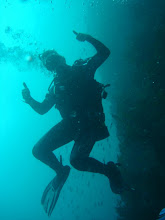Directly from the airport we made a beeline for the Manjang-gul Lava tubes, allegedly the world's largest. Though stretching 40km's underground, for safety reasons tourists are limited to the first 2km's. The cavernous tunnels, formed from the lava flow of Jeju's extinct (hopefully) volcanoes, the creepy and cold, damp atmosphere was surreal and otherworldly, and offered a unique experience and a great first hour on the island.
Next we ventured to Jeju's eastern tip, to the famed Ilchulbong, a perfectly formed volcanic crater that protrudes from the main island like a giant grassy eggcup. The short hike to the top afforded amazing views, and was well worth the effort. Koreans consider this almost a 'rite of passage,' and throngs of people of all ages were swarming the trails like ants, albeit very noisy and colourful ones. Also known as sunrise point, I am sure dawn would be a magical time to visit. For my Lowestoft friends and family, 'Ness Point' it most certainly isn't.
The weather forecast suggested that the best time to hike Halla-san (Halla Mountain) was the next day, Friday, so after leaving Leslie snoozing at 5:45a.m. and ensuring an early start, I grabbed a bus to as near as I could get to the trail head. After hitch hiking the last 3 miles courtesy of a kindly Buddhist monk en-route to Gwaneum-sa (temple), I finally hit the trail at 7:20. Opting for the Gwaneum-sa trail, the most difficult but supposedly the more spectacular route, I expected to see many fellow hikers. I guess the dismal weather put paid to that, as the forecast couldn't have been more wrong. However, far from downhearted I was committed to reach the summit, so I headed into the drizzly & forested lower reaches of Halla-san, and with only the mist bound trees and whistling breeze for company, I made my way steadily upwards. In all honesty, there wasn't a lot to see. All around me was dense befogged woodland, and whenever there was a break in the tree cover, the thick grey clouds obscured any views on offer. Still, I pressed on and 90 minutes into my ascent I met my first fellow hiker, a middle aged Korean dude as equally surprised to see me as I was him.


After exchanging pleasantries we convoyed upwards, eventually escaping the claustrophobic forest and getting a glimpse of the renowned Halla-san scenery. Despite thick, moisture heavy clouds, it was impressive, and with autumn colours adding fire to the greens and greys, I couldn't deny it's beauty.

After trudging to the summit in 3 hours I found myself whipped by icy winds, stinging my legs and my eyes with a vengeance. The roof of Korea is home to a beautiful blue crater lake at the centre of the long dormant volcano: at least that is what I was told. The reality was far less appealing, more of a large, brown puddle, surely home to rats, eels...Gollum? So here I was, at 1,950m officially the highest person in the whole of South Korea, freezing, wet and more than a little underwhelmed. After maybe five minutes atop Halla, I began my descent via an alternative route, the less demanding but slightly longer Seongpanak Trail. This was a mistake. I had entered a bottle neck, and was faced head on by possibly half the population of Korea. Taking this easier route down might have been less arduous on my creaking joints, but it was a thorough test of my patience. I love Korea, and I really like Koreans, but after letting through the first hundred or so hikers without as much as a nod or a Kamsa-hamnida (thanks) I decided to adopt their philosophy, and left my manners and good will trail-side. Suddenly I was making good ground, and two hours and fifty minutes later I'd completed my descent. All in all I really enjoyed my hike, and of course I did meet some very polite and friendly Koreans, despite my whining to the contrary. With a little more luck with the weather I am sure Halla-san would have been as spectacular as I imagined it.
Back at sea level, Leslie and I explored the delightful and underrated Seogwipo, a very picturesque fishing town, and with towering waterfalls and pretty walks along 'The Olle Trails,' it was great spot to stay a few days. With Leslie off for more research at amongst other places, 'Loveland,' I wisely opted against visiting a theme park containing sculptures of giant sex organs and other carnal exhibits, and instead went Scuba diving. After a long hot summer the waters off Seogwipo promised to be warm, and I was keen to add to my slowly growing list of dive destinations. I met my guide and dive buddies at the dive shop, we loaded the gear, and took the short fishing boat ride out to Munsom Island.
With majestic Halla-san as a back drop & clear blue skies, it augured excellent diving. Descending to 35m the visibility was 25m, the best I've ever known, and the coral and myriad fish were dazzling. My dives were great, and heightened the excitement of my imminent dive trip with my brother to Bali.
As our time on Jeju came to a close, I left feeling that I was heading back to Korea. Jeju Island, although of course still very much Korea, had a totally different feel to it than the mainland. Perhaps it was the clean air, or the swaying palm trees. Perhaps when vacation time is limited, we just have a heightened sense of things and perceive our time differently. Maybe I just didn't want to go back to work? Whatever it was, Jeju was a really refreshing break, and although I can't quite agree that Jeju is Korea's Hawaii, I can whole-heartedly attest to it being extremely laid back, almost tropical, and an exciting, adventure filled and beautiful island.













